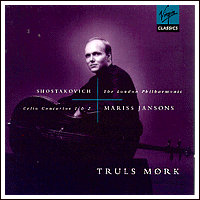
SHOSTAKOVICH
Cello Concerto No. 1 in E flat major, Op. 107
(1959)
Cello Concerto No. 2, Op. 126 (1966)
Truls Mork (cello)
The
London Philharmonic cond. Mariss Jansons
Virgin Classics VC545145-2 [65:56
DDD]

SHOSTAKOVICH
Cello Concerto No. 1 in E flat major, Op. 107
(1959)
Cello Concerto No. 2, Op. 126 (1966)
Truls Mork (cello)
The
London Philharmonic cond. Mariss Jansons
Virgin Classics VC545145-2 [65:56
DDD]
That all of Shostakovich's music is, in a sense, vocal is nowhere plainer than in his cello concertos, where the sighs and curses of the soloist contrast with the harsh laughter and Bosch-like leers of the woodwind. Indeed, the clearer the composer's meaning becomes in such works, the more emotionally unbearable they seem. Interviewed by Elizabeth Wilson, Sofia Gubaidulina has reflected sombrely on the period of the First Cello Concerto's creation: "The circumstances he lived under were unbearably cruel, more than anyone should have to endure." Marina Sabinina recalls Shostakovich behaving "like a frenzied maniac" shortly after being forced to read an official speech to the Composers' Union in 1956. "I read," he repeatedly shrieked, "like the most paltry wretch, a parasite, a puppet, a cut-out paper doll on a string!" That grotesque episodes like this are part of the nightmare world of the First Cello Concerto's outer movements does not require much acumen to discern.
Shostakovich's musical model for his First Cello Concerto was Prokofiev's Symphony-Concerto (1952), an enigmatic revision of the composer's already revised First Cello Concerto, which had reached its final form during the Terror in 1938. Apart from reworked material, the main common factor between the two works was Mstislav Rostropovich, whose première recording of Shostakovich's First Cello Concerto with the Philadelphia Orchestra under Eugene Ormandy (Sony CD44850) remains outstanding. Rostropovich's character and abilities must have played a part in shaping the work. What Shostakovich was driving at in general is a different question. Evgeny Chukovsky reports him as saying "I took a simple theme and tried to develop it." As a summary of the First Cello Concerto, this is so clearly inadequate that we must assume he was referring to one section of it (the first movement), or - more probably - that he was being deliberately evasive. (That he wished to keep his head down over this work is obvious from the finale's allusion to the Georgian folk-song "Suliko" - so carefully buried that even Rostropovich didn't notice it until Shostakovich pointed it out to him.)
Shostakovich referred to the work's opening movement as "an ironic march". As André Lischke notes, this is an extremely euphemistic description: "The irony rapidly becomes mordant sarcasm emphasised by the caustic and raw timbres of the woodwinds and the aggressive mottoes in the solo part. A particularly spectacular passage in the recapitulation is the duo of the soloist with the horn, a dramatic confrontation suggestive of scenographical visions." (My italics.) Of the similarly "ironic" finale, Lischke comments: "Gaunt, harsh, rhythmic, it could very well bear the imprint of hints of the terrible years in Shostakovich's life. It is certainly not by chance that shortly after the beginning we hear the strings playing the opening phrase of a well-known tune, 'Suliko' (E flat repeated, C, D flat, E flat), which gained notoreity from having been Stalin's favourite song. The fact that Shostakovich quoted it in its entirety in his satirical cantata Rayok to caricature the Little Father of the People, tends to confirm the real intention behind its presence here." (For details, see Wilson, Shostakovich Remembered, pp. 477-79.)
Truls Mork and Mariss Jansons approach the outer movements with a driving attack, blurred slightly at fortissimo by a bass-heavy balance. Tempo for the moderato is slow, picking up as the movement progresses. Mork, though, sounds as if he's playing from the outside, his phrasing gestural and his tone undifferentiated. Much the same occurs in the Second Cello Concerto, which falls a long way short of Rostropovich's première recording with Ozawa (DG Galleria 431475-2). There are no tokens of insight here, such as, for example, Ivan Monighetti brings to the shudders of revulsion after the climax of the work's finale (9:45) in his Chant du Monde recording (LDC 278 1099).
Couplings of Shostakovich cello concertos are becoming more common, but it's not easy to make clear recommendations. Schiff, the normal choice, is somewhat stolid. Maisky and Tilsson Thomas have won good opinions for their 1995 version on Deutsche Grammophon. (I've not heard it.) However, if you don't need digital sound, Rostropovich's live recordings with the USSR Symphony Orchestra under Yevgeny Svetlanov on Russian Disc (RDCD 11109) are hard to beat. Recorded in the bitter dawn of Brezhnev's repression, these performances are as acerbic as Kondrashin's 1969 Prague reading of the Eighth Symphony. Here projected with astonishing vehemence, the finale of the First Concerto explodes at an almost unplayable pace. If wobbly horns and a backward solo image put this pairing off-limits for beginners, devotees will be gripped, illuminated, and shaken by these blazing performances.